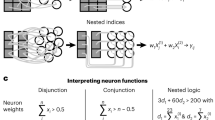Abstract
We look at distributed representation of structure with variable binding, that is natural for neural nets and that allows traditional symbolic representation and processing. The representation supports learning from example. This is demonstrated by taking several instances of the mother-of relation implying the parent-of relation, by encoding them into a mapping vector, and by showing that the mapping vector maps new instances of mother-of into parent-of. Possible implications to AI are considered.
Preview
Unable to display preview. Download preview PDF.
Similar content being viewed by others
References
Bodén, M.B., Niklasson, L.F.: Features of distributed representation for tree structures: A study of RAAM. In: Niklasson, L.F., Bodén, M.B. (eds.) Current Trends in Connectionism, Erlbaum, Hillsdale, NJ, pp. 121–139 (1995)
Chalmers, D.J.: Syntactic transformations on distributed representations. Connection Science 2(1-2), 53–62 (1990)
Gayler, R.W., Wales, R.: Connections, binding, unification and analogical promiscuity. In: Holyoak, K., Gentner, D., Kokinov, B. (eds.) Advances in Analogy Research: Integration of Theory and Data from the Cognitive, Computational, and Neural Sciences (Proc. Analogy 1998 workshop, Sofia). NBU Series in Cognitive Science, pp. 181–190. New Bulgarian University, Sofia (1998)
Hinton, G.E.: Mapping part–whole hierarchies into connectionist networks. Artificial Intelligence 46(1-2), 47–75 (1990)
Hummel, J.E., Holyoak, K.J.: Distributed representation of structure: A theory of analogical access and mapping. Psychological Review 104, 427–466 (1997)
Kanerva, P.: Binary spatter-coding of ordered K-tuples. In: Vorbrüggen, J.C., von Seelen, W., Sendhoff, B. (eds.) ICANN 1996. LNCS, vol. 1112, pp. 869–873. Springer, Heidelberg (1996)
Kanerva, P.: Dual role of analogy in the design of a cognitive computer. In: Holyoak, K., Gentner, D., Kokinov, B. (eds.) Advances in Analogy Research: Integration of Theory and Data from the Cognitive, Computational, and Neural Sciences (Proc. Analogy 1998 workshop, Sofia). NBU Series in Cognitive Science, pp. 164–170. New Bulgarian University, Sofia (1998)
Kussul, E.M., Rachkovskij, D.A., Baidyk, T.N.: Associative-projective neural networks: Architecture, implementation, applications. In: Proc. Neuro-Nimes 1991, The Fourth Int’l Conference on Neural Networks and their Applications, pp. 463–476 (1991)
Plate, T.A.: Distributed Representations and Nested Compositional Structure. PhD thesis. Graduate Department of Computer Science, University of Toronto (1994), Available by ftpatftp.cs.utoronto.caas/pub/tap/plate.thesis.ps.Z
Plate, T.A.: A common framework for distributed representation schemes for compositional structure. In: Maire, F., Hayward, R., Diederich, J. (eds.) CADE 1997. LNCS, vol. 1249, pp. 15–34. Springer, Heidelberg (1997)
Pollack, J.P.: Recursive distributed representations. Artificial Intelligence 46(1-2), 77–105 (1990)
Rachkovskij, D.A., Kussul, E.M.: Binding and normalization of binary sparse distributed representations by context-dependent thinning. Manuscript available at http://cogprints.soton.ac.uk/abs/comp/199904008
Sharkey, N.E.: Connectionist representation techniques. AI Review 5(3), 143–167 (1991)
Shastri, L., Ajjanagadde, V.: From simple associations to systematic reasoning. Behavioral and Brain Sciences 16(3), 417–494 (1993)
Wermter, S.: Hybrid Approaches to Neural-Network-Based Language Processing. Report ICSI TR-97-030, International Computer Science Institute, Berkeley, California (1997)
Author information
Authors and Affiliations
Editor information
Editors and Affiliations
Rights and permissions
Copyright information
© 2000 Springer-Verlag Berlin Heidelberg
About this paper
Cite this paper
Kanerva, P. (2000). Large Patterns Make Great Symbols: An Example of Learning from Example. In: Wermter, S., Sun, R. (eds) Hybrid Neural Systems. Hybrid Neural Systems 1998. Lecture Notes in Computer Science(), vol 1778. Springer, Berlin, Heidelberg. https://doi.org/10.1007/10719871_13
Download citation
DOI: https://doi.org/10.1007/10719871_13
Publisher Name: Springer, Berlin, Heidelberg
Print ISBN: 978-3-540-67305-7
Online ISBN: 978-3-540-46417-4
eBook Packages: Springer Book Archive




